#hiroshima prefectural commercial exhibition hall
Explore tagged Tumblr posts
Text

Ruines du Hiroshima Prefectural Commercial Exhibition Hall (aujourd'hui Atomic Bomb Dome) – Hiroshima – Japon – 24 octobre 1945
#WWII#guerre du pacifique#pacific war#bombardements stratégiques#strategic bombing#bombe atomique#atomic bomb#les ravages de la guerre#ravages of war#hiroshima prefectural commercial exhibition hall#hiroshima peace memorial#atomic bomb dome#genbaku dome#hiroshima#japon#japan#24/10/1945#10/1945#1945
11 notes
·
View notes
Photo

The Hiroshima Prefectural Commercial Exhibition Hall .. [After]
A model of the A-bomb dome post Aug 6, 1945. At the Hiroshima Peace Memorial Museum, Hiroshima, Chugoku.
Originally designed by Czech architect Jan Letzel, and completed in Apr 1915, the Hiroshima Prefectural Commercial Exhibition Hall's business functions included commercial research and consulting services and the display and sale of prefectural products, and the hall was also used for art exhibitions, fairs, and cultural events. It was also known aslater as the Prefectural Industrial Promotion Hall. During WW2, it was taken over by the Chugoku-Shikoku Public Works Office of the Interior Ministry, the Hiroshima Lumber Control Corporation, and other government agencies.
1 note
·
View note
Text
Leopold II is Part of the Uncomfortable Truth of Who We Are. We Can’t Erase Him
— 06/11/2020 | By Assita Kanko | EuroNews.Com
VIEW ǀ "When it comes to the statues of figures like Leopold II, I understand the frustrations and the anger at their daily presence. I understand the desire to avoid their glorification, and instead offer condemnation. But there is danger in cleansing our history to reflect who we wished we were, rather than who we actually have been." — Assita Kanko MEP
— Opinions expressed in View articles are solely those of the authors.

I was born in Burkina Faso. My grandparents told me stories of living under colonialism, and my young parents told me the stories their parents had told them. I grew up in a soci-ety where the weak grip upon democracy was created by the legacy of a struggling politi-cal system left in the wake of the French retreat.
The tragic death of George Floyd has prompted all of us to ask some difficult questions about who we are, and how the society around us was formed. Topics that were once confined to awkward conversations at the dinner table or debates within the corners of the academic world, have flooded the public consciousness in a way not seen since the civil rights protests of the 1960s.
The death of George Floyd has lit a powder keg of decades of social and economic ine-qualities and frustrations. The movement rose from grief and injustice like a phoenix from the ashes. It prompted much-needed conversations on societal bias, abuse of power, fail-ings in healthcare, education and policing. It took an issue that had impatiently waited generations to be discussed, and placed it on every newsfeed, every social media platform and in newspaper.
There is danger in cleansing our history to reflect who we wished we were, rather than who we actually have been. — Assita Kanko, MEP
Debates over how best to forge equality have always had the potential to divide rather than unite. While the vast majority of people have protested peacefully, there are those that seek to create a narrative of all black people are oppressed and all whites people are privileged. As grief morphed into protest, and protest morphed into anger and retribution, it’s been decided by some that heads should roll; stone heads that is.
It has been decided by some that certain historical figures no longer have a place in a vi-sion of a curated and sanitised version of our history. The problem with that is that it makes cartoon heroes and villains of people. It places Churchill in the same category as a slave trader and Leopold II in the same column as Pol Pot. As I sit and write this, dozens of police officers surround a statue of Churchill in order to prevent its destruction. Yet, it wasn’t Churchill that caused the biggest genocide in human history, or ensured that black people living in Nazi Germany were persecuted, alienated and murdered. No, Churchill helped bring that to an end.
In January this year, I visited Auschwitz. Its power will always haunt me; the hair, the shoes, the bitter cold. It taught me more about loss, sacrifice, and human dignity that no text book ever could. Although I knew its history, it was another thing to see it. It showed me that although parts of our history will make us uncomfortable and horrified, and at times make us question the very humanity that lives within us; their presence is needed.
After the atomic bomb hit the domed Hiroshima Prefectural Commercial Exhibition Hall, it somehow retained some of its walls and the steel frame of the dome. This structure quickly became a symbol of destruction, survival and rebuilding. The building is now the main attraction at the Hiroshima Peace Memorial Park. “Those who cannot remember the past are condemned to repeat it,” but not only must we remember our history, we need to see it.
When it comes to the statues of figures like Leopold II, I understand the frustrations and the anger at their daily presence. I understand the desire to avoid their glorification, and instead offer condemnation. But there is danger in cleansing our history to reflect who we wished we were, rather than who we actually have been.
It should never be the place of mob rule to decide who makes the cut and doesn’t of our age-old story. In a democratic society, those decisions are a consequence of debate and collective decision-making. To destroy our history rather than contextualise it, would be a mistake. In a 280-character world, the debate on black lives matter, requires nuance.
As a black woman, I have never been defined by words like diversity, inclusion and quotas. I am not the product of inadequate government policy, historical ignorance or online hate. I am the product of my own hard work and ambition, and my parents’ belief that the sky was the limit.
— Assita Kanko, MEP
History is complicated. Our attitudes towards it will change and evolve with time. Through the prism of the present, with all of its progress and political correctness, many of our historical figures - and even our heroes - will be found to be flawed. Do we cease to read Voltaire, Shakespeare, Dickens or Melati van Java? With every passing day, we seek to argue over the merits of the past rather than try to understand its impact on the present, missing an opportunity to move forward.
Instead of throwing a can of red paint over a statue of a man most people probably didn’t know the name of a week ago, we should do more as a society to understand who these people are. We need to talk about how King Leopold drew some 220 million francs from the Congo during his lifetime, and how at the Expo 58 in Brussels, Congolese men, women and children were put on show in “traditional” dress behind a fence like a human zoo. Genocide, war and slavery are the dark shadows of our world history. It is a history that should never be forgotten, but one which mustn’t define us.
As a black woman, I have never been defined by words like diversity, inclusion and quotas. I am not the product of inadequate government policy, historical ignorance or online hate. I am the product of my own hard work and ambition, and my parents’ belief that the sky was the limit. If we wait for others to change in order to change our own lives, we are doomed to give away our own power and fall short of fulfilling our dreams.
We must teach our children that aspiration and tolerance are the weapons of choice when it comes to making your mark on the quest for change. We all need to show up, fight for what’s right, speak up against what is wrong, and play our part in creating a better world through the power of positivity and progress. So, how can we best honour George Floyd? By all of us being a better version of ourselves.
— Assita Kanko is a Belgian Member of the European Parliament for the New Flemish Alliance
0 notes
Text
Day 5, 31st March, Imabari
Wonderful day today in and around Hiroshima. Breakfast was first with the sun rising over the water.
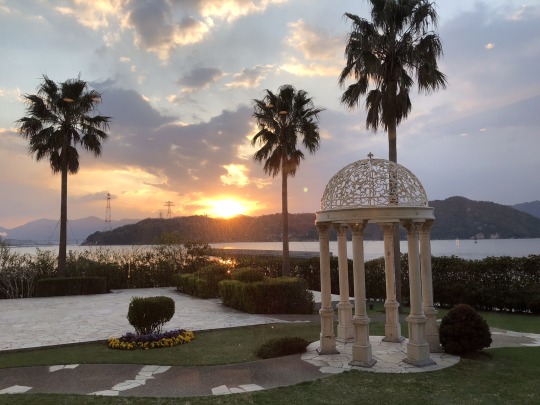
Our hotel was on the harbour so lovely to be able to walk along the foreshore.
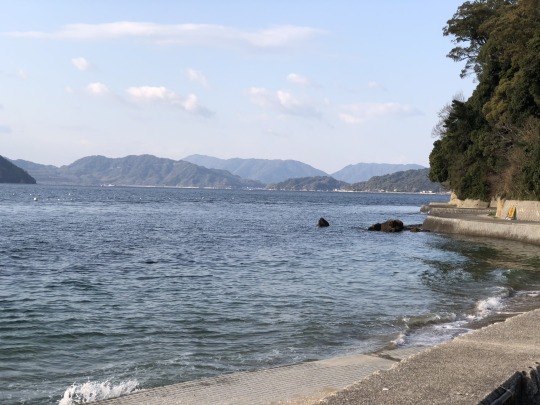
Hiroshima, like a lot of Japanese cities, was fairly non descript for the most part. Not a lot of colour or trees in among the buildings.

Golf driving range.
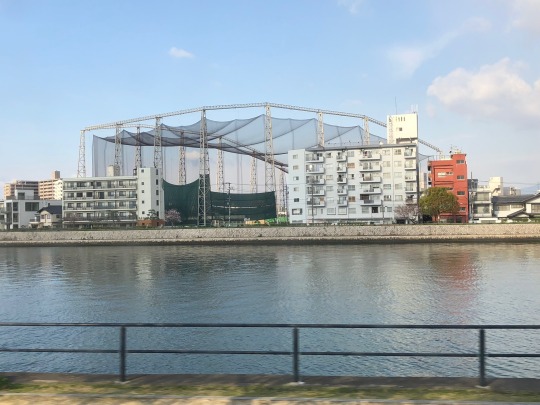
There are a lot of water ways throughout the city.
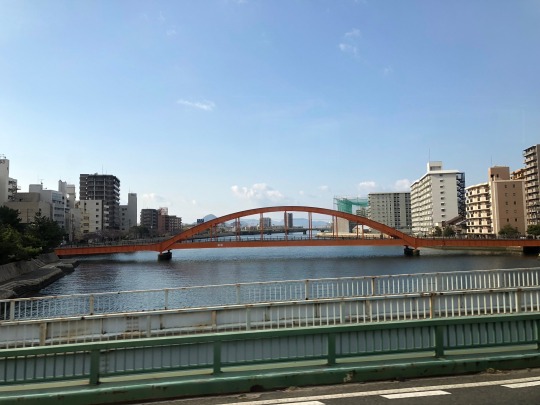
Cherry blossoms along the waterfront.
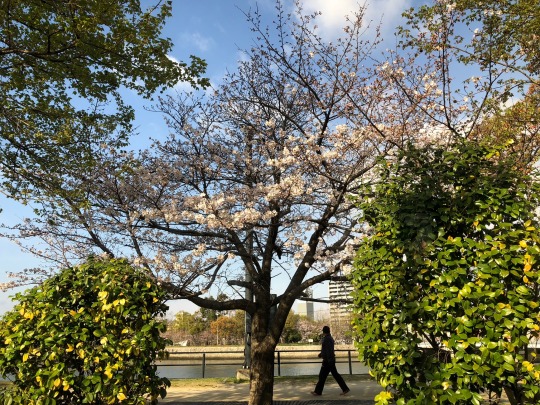
Rain was predicted today so when the Japanese want the day to be fine they make paper boys and as many as they can for good weather.
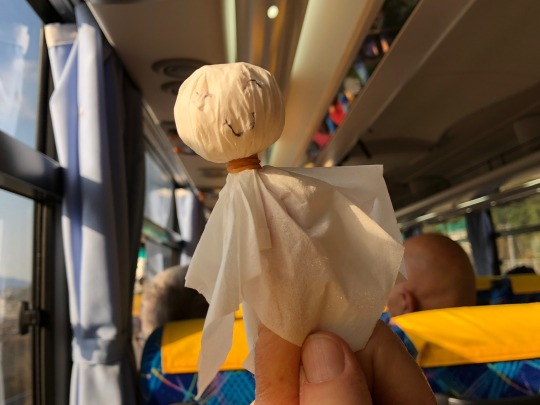
We were catching a ferry to the island of Miyajimacho. Next to the ferry terminal was a boat racing course. Gambling is illegal in Japan but there are four types of gambling the Japanese government allows. Horse racing, cycling, motor cycles and boat racing.

Boat racing is fairly popular but mostly for the men. The boats are only small. A bit like a go cart size.
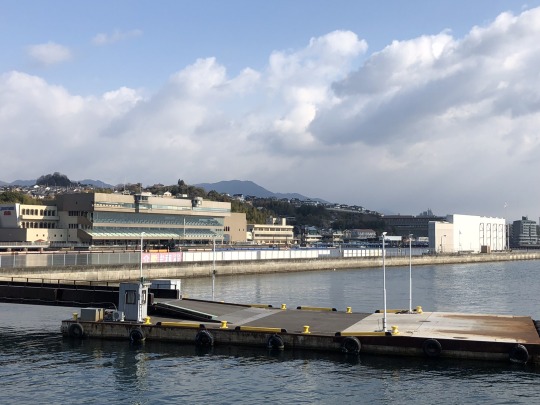
The Japanese queue to get on transport so we were being good lining up for the ferry.

Kymie buying the ferry tickets.
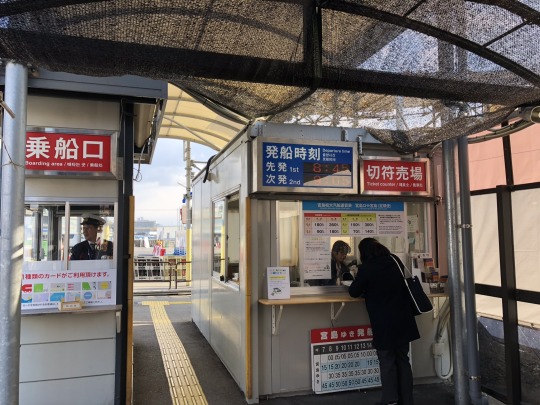
Leaving port.
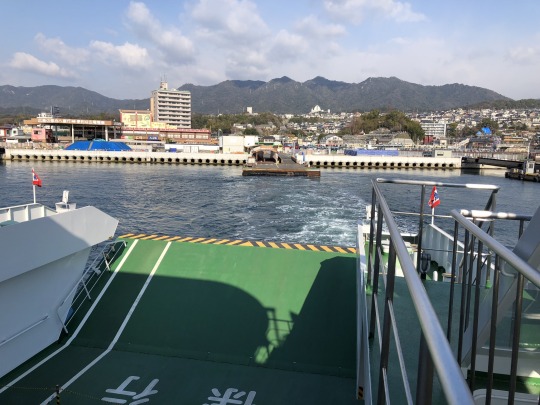
The Ferries leave often and it takes about 15 minutes to get to Miyajima Island which has a World Heritage listing.
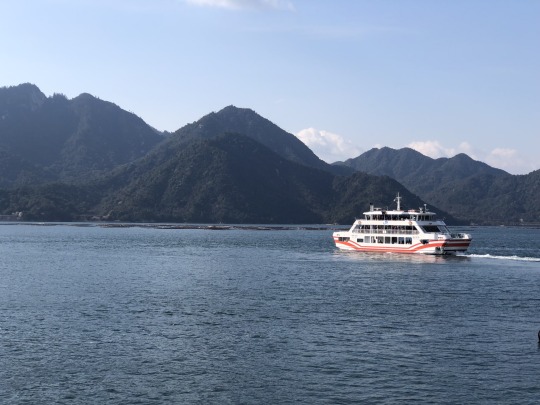
From the ferry we walked along the foreshore. We had caught the ferry early to beat the crowds which certainly increased as the day progressed.
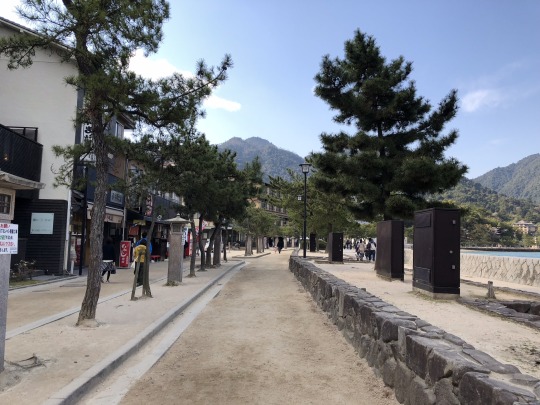
Looking back across the harbour to a fairly new All Religion Church. There are a number of these in Japan and encompass Buddhism, Islam, Christianity etc.
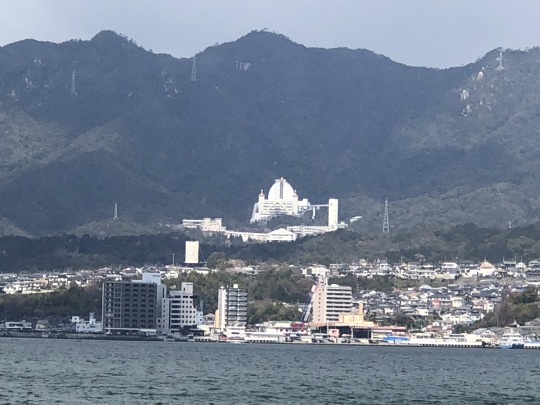
The sun had come out so a lovely sight looking towards the O-Tori’s Gate. Miyajima has been worshipped as a divine island since ancient times. This is why the shrine was built on the seashore where the tide ebbs and flows. The contrast of the blue sea, green hills and vivid vermilion-lacquered shrine is breathtakingly beautiful.

In front the gate to the Shrine. A female and male temple dog guarded the entrance. The female is the one with her mouth open as the guys pointed out it was because females talk so much.
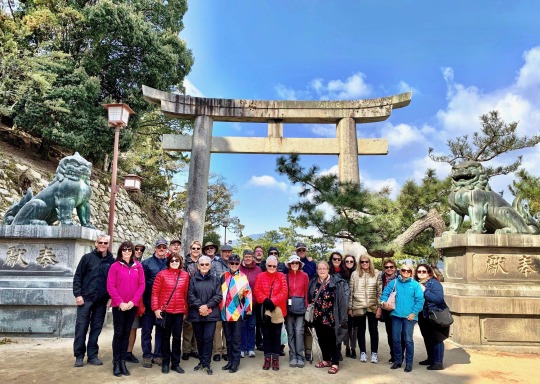
The O- Tori’s Gate
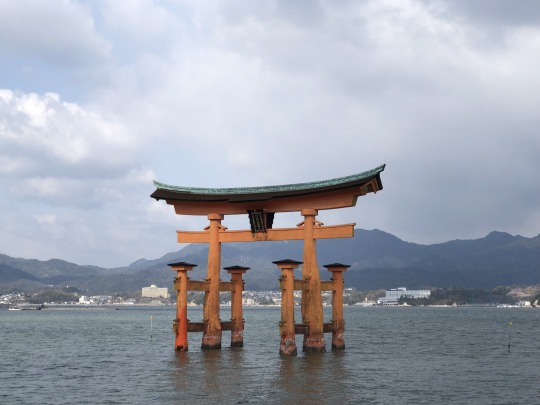
The Itsukushima Shrine was first built in 593, then rebuilt in 1168 on the same scale as today. The Shrine has never been affected by earthquakes or typhoons.
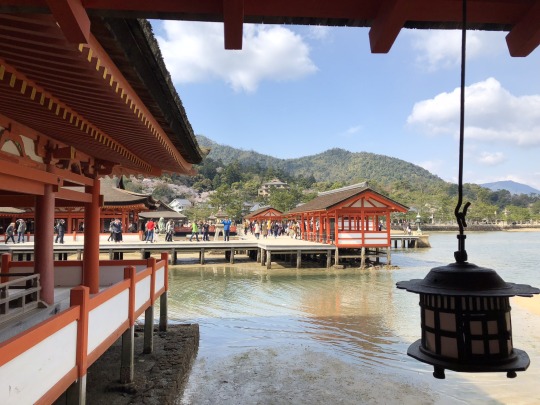
A corridor of some 280 metres spans more than twenty buildings

People giving thanks.
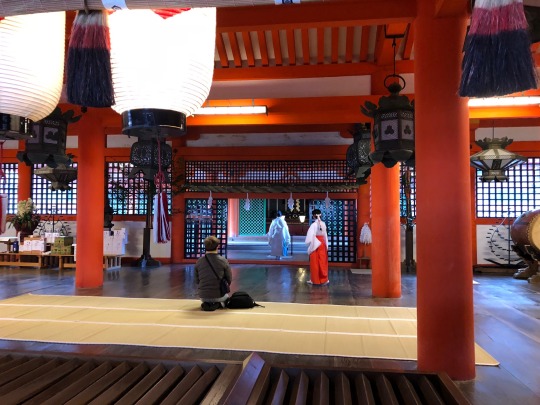
Looking out to the O-Tori’s Gate.
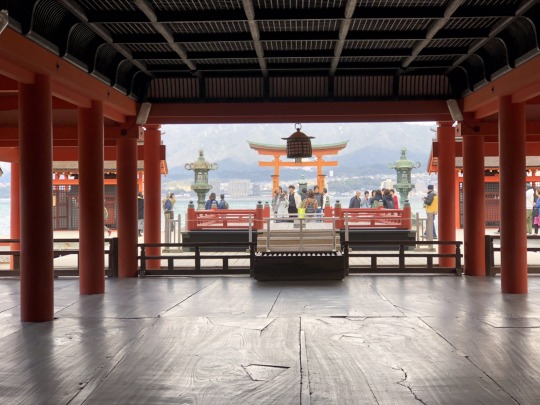
Three lovely ladies.
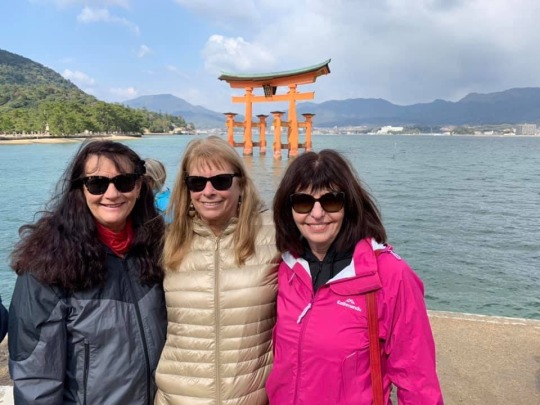
Sake barrels

This bridge is so steep humans couldn’t walk over it. It’s designed for the Gods to use.
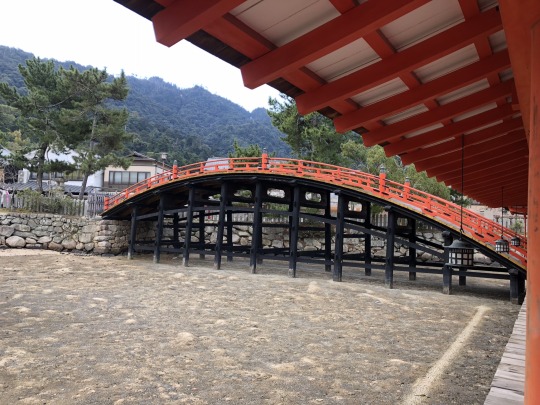
Shopping street
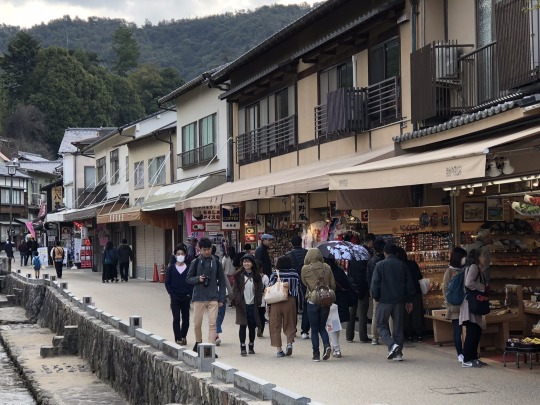
Beautiful couple

Elaborate detail of back of the kimono.

Cherry blossom
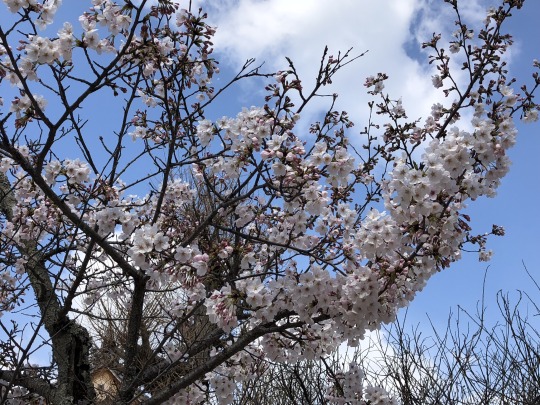
Daiganji Temple

Cherry blossoms and me. There were deers in the canal.

You can never get enough of the cherry blossoms.

Five storied pagoda
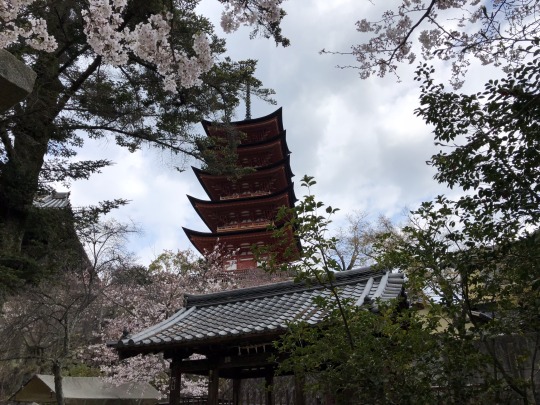
Rickshaw

Blossom tree

Another shopping street
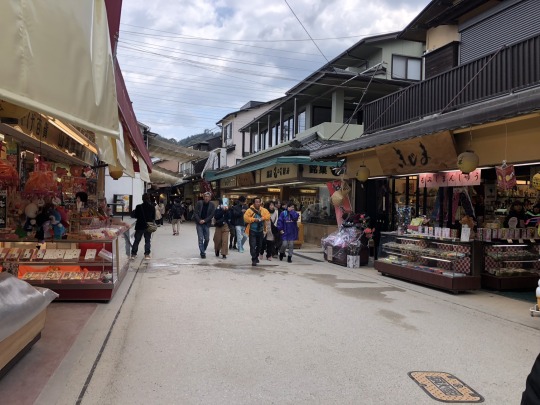
There were a lot of stalls selling oysters.
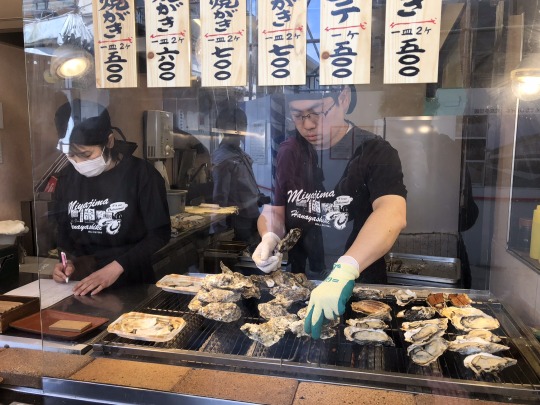
This was a pastry in the shape of a maple leaf filled with custard, apple or choclate. Very yummy.
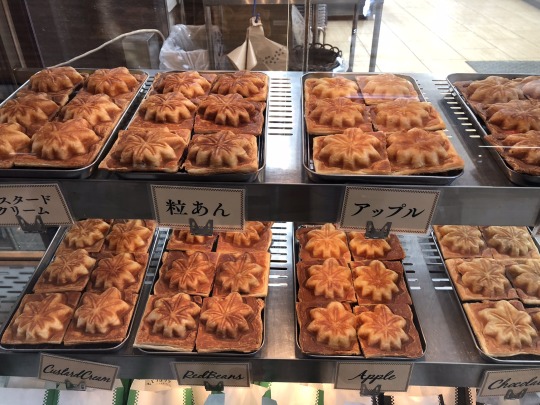
Heading back on the ferry. The ferry was virtually empty going back but big lines waiting on the other side.

This building is now known as the A bomb Dome but was orginally the Hiroshima Prefectural Commercial Exhibition Hall which was a distinctive landmark with its green dome. It was built in 1915.
At 8.15am on Aug 6 th 1945 an American B29 bomber carried out the world’s first atomic bombing. The bomb explosed approx 600 m above the building ripping through and killing everyone instantly. Because the blast was almost directly above the building some of the centre walls remained.
Initially opinion was divided about the dome but when other affected buildings were demolished it was decided to leave this building as a memorial to the bombing.
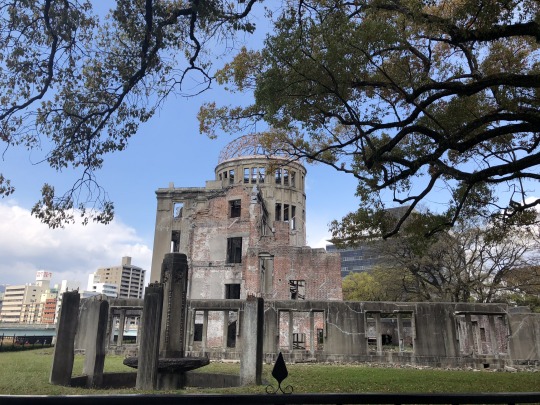
This is the children’s memorial which is also at the Hypocentre of the bombing. The city was hit by heat rays of 3,000 to 4,000 degree C along with a blast wind and radiation.
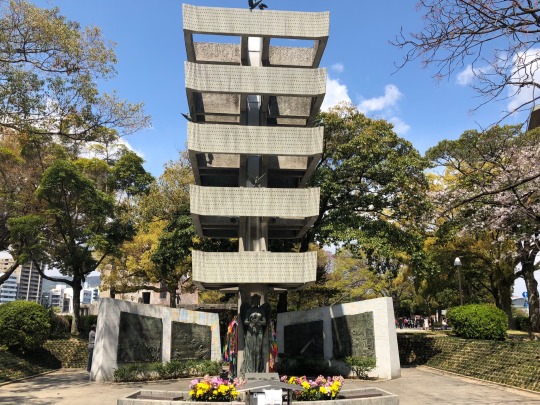
Near this area are shopping streets which are covered. We all enjoyed a wander and some lunch.

Eating Okonomiyaki a local dish.
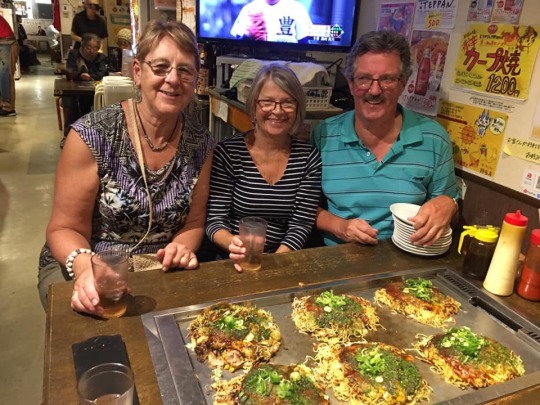
Looking across to the Hiroshima Peace Park
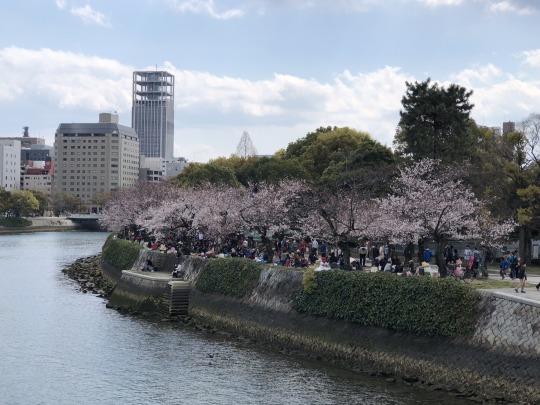
It was a Sunday so lots of people out enjoying a picnic.

A young girl called Sadako was exposed to the radiation from the atomic bomb. Ten years later she developed leukaemia and died. Her classmates called for a monument to all children to be built. With donations from 3,200 schools and nine countries the Children’s Peace Monument was unveiled in 1958.
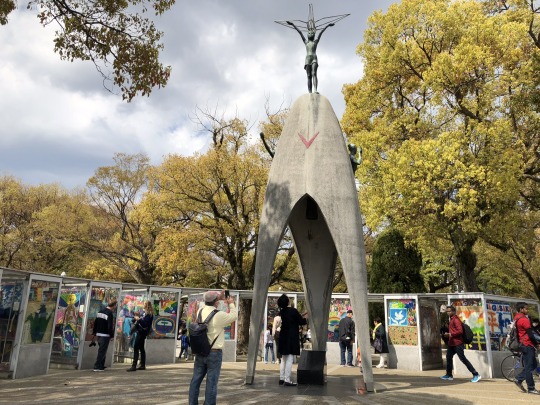
The story goes that Sadako wanted to make 1000 cranes to help her get well. Her classmates and family helped her. However she only got to make 620 cranes before she past away. The paper crane is now found at many memorials in all colours with some forming pictures. Behind the monument are glass boxes full of the cranes.
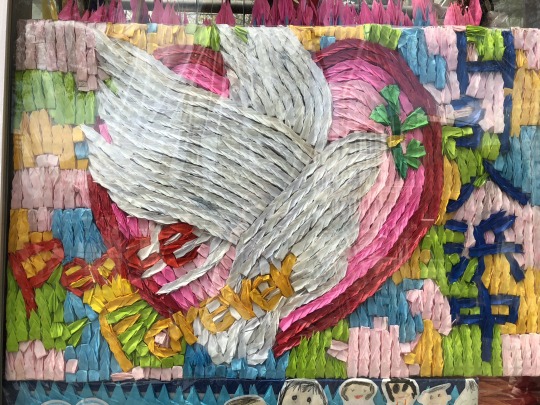
A Japanese family enjoying the day out. Even though the events that lead to the park being made are very somber its such a lovely area that on a beautiful day people are out to enjoy themselves. Except for a few westerners you don’t see many other nationalities around. Japan doesn’t really allow immigration and takes only a handful of refugees.

The
Peace Memorial Park. The park was started in 1950 and completed in 1954 it was built to comfort the souls of the victims and to pray for everlasting world peace. 145,000 people lost their lives in the bombing. Many instantly.
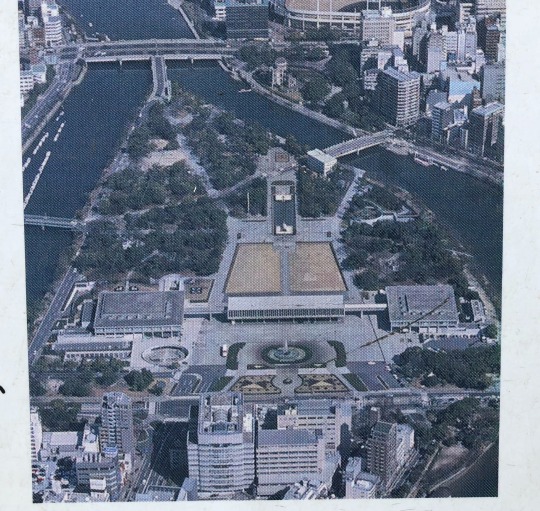
Looking towards the Hiroshima Peace Memorial Museum. The museum collects and displays belongings left by the victims, photos and other material that conveys the horror of the event.
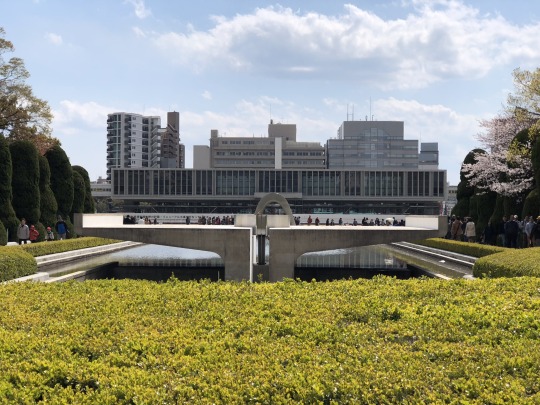
Looking back to the A dome. President Obama visited Japan in 2016, layed a wreath here and gave a speech after visiting the museum.
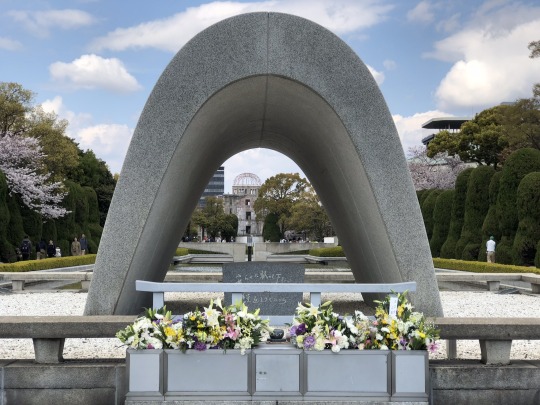
When the bomb landed.
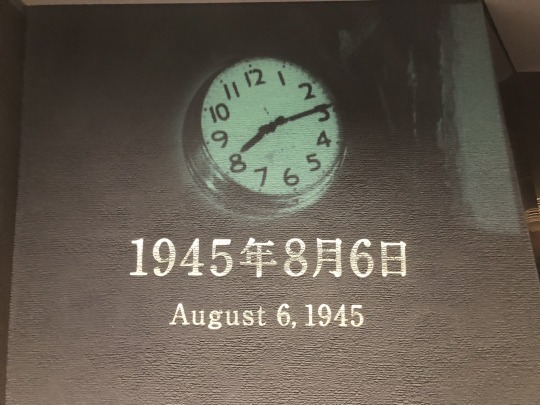
Ruins.
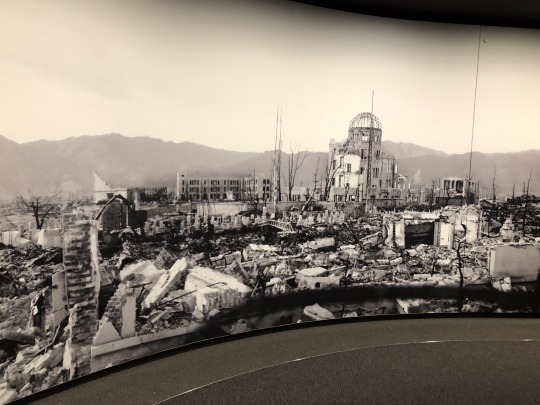
Map of the bombed area.
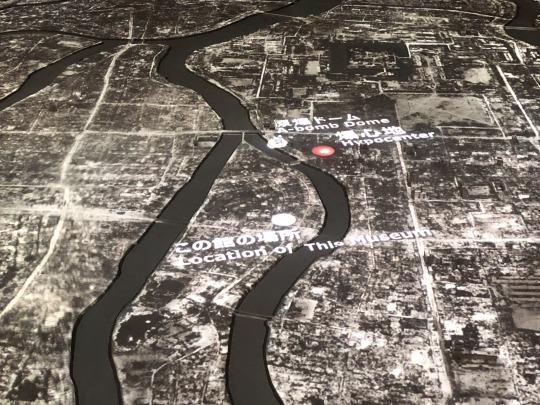
A poignant poem about the desperate need for water by the survivors.

This bicycle was buried, after the bomb, with the owners and discovered recently when the family were doing some building work. The skeletons of the children were found and they were holding hands. It’s usual for bodies to be cremated in Japan so the skeletons were cremated and the bicycle donated to the museum.

Survivors
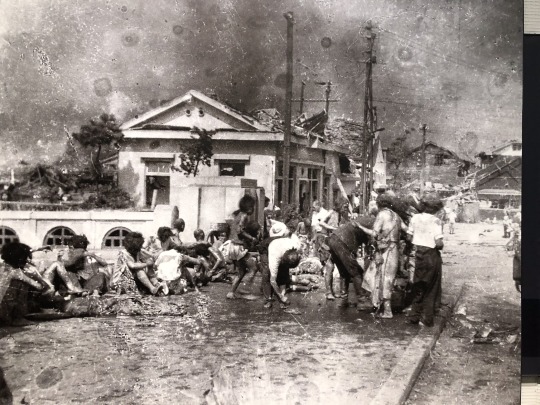
Leaving Hiroshima we travelled on a 60 km long toll road that connects Japan’s main island of Honshu to the island of Shikoku passing over six small islands in the Seto Inland Sea. It is also known as the Nishiseto Expressway. The road was opened in 1999.
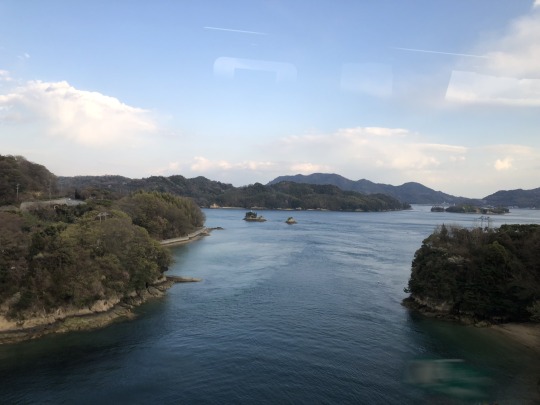
Each bridge has a different design.
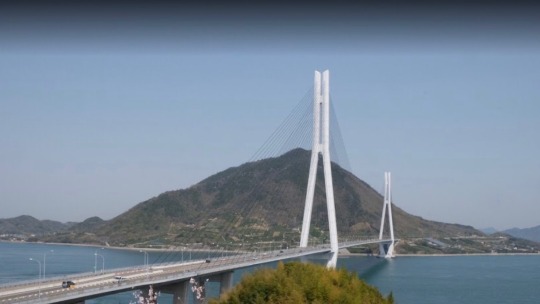
Lots of lovely scenery along the way.
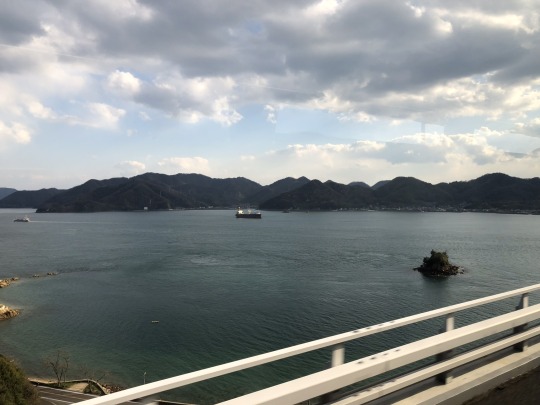
Each bridge was very impressive.

There was a lot of evidence of ship building in many settlements.

The bridges are all big structures.
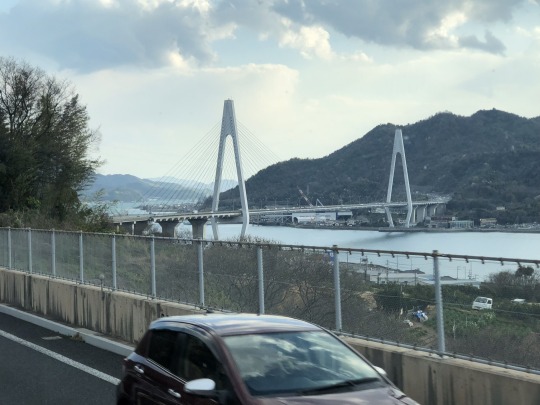
Settlement along the coast.
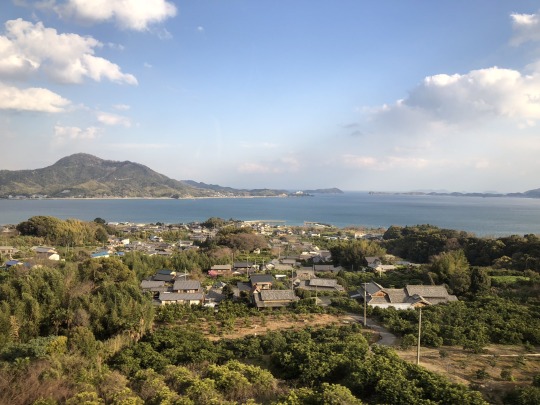
The bus wound up the mountain to the Kirosan Panorama Park. It was a pity it was getting late in the day. Below was the last bridge we had to cross.
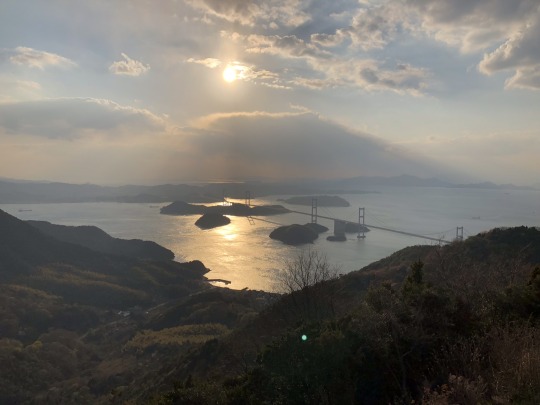
The guys taking the girls photo.
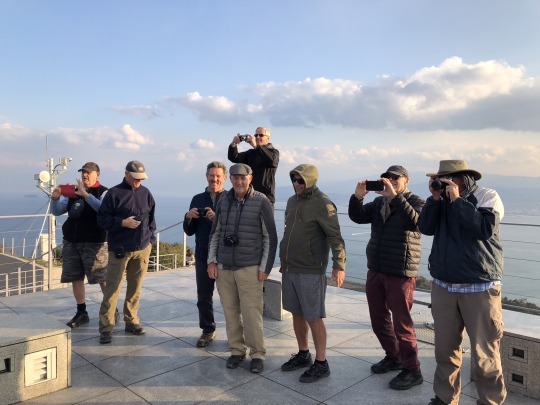
All the girls minus two.
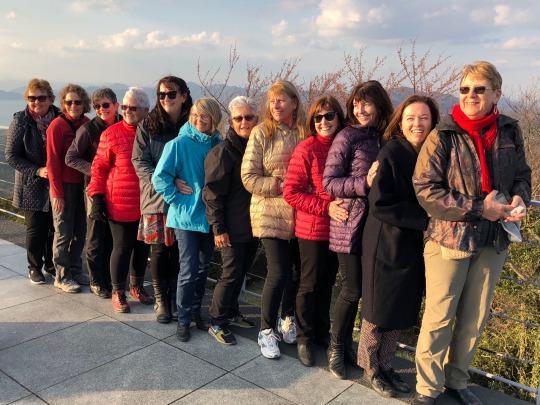
Looking south.

Hotel foyer, very nice. The Japanese are so efficient with check in. Our keys are waiting for us so we can walk-in and go straight to our rooms.
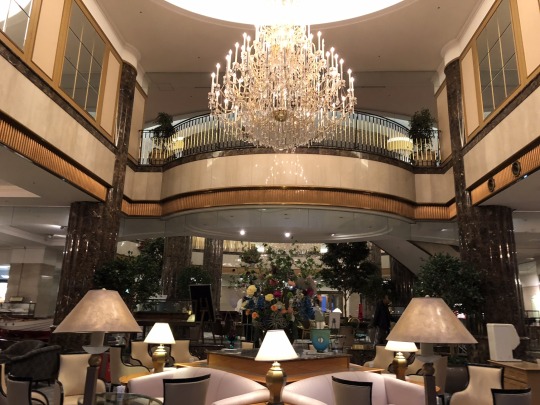
Lovely lounge
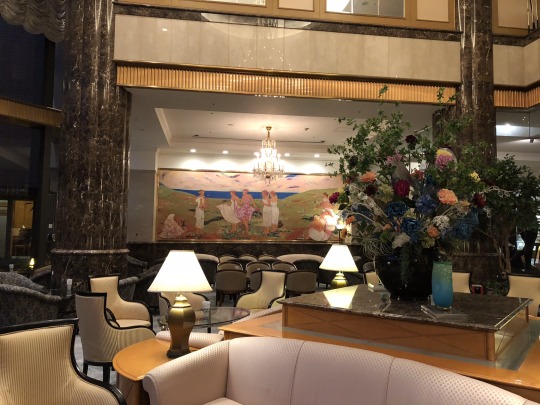
Looking down on the city of Imabari. The last bridge can just be seem in the distance.

Sunset from our 19th floor hotel room. This was probably the nicest hotel so far but they do all blend into each other.
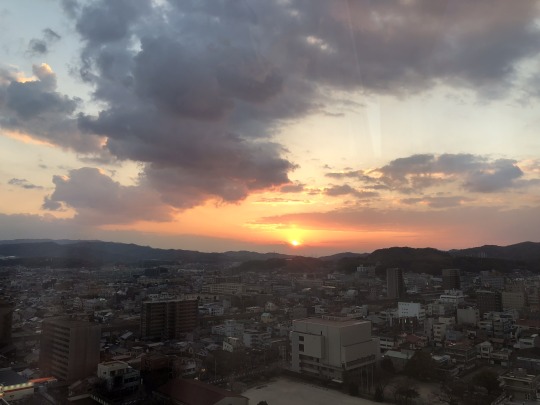
Another interesting meal. So many different pretty dishes. Washing up would be a nightmare.
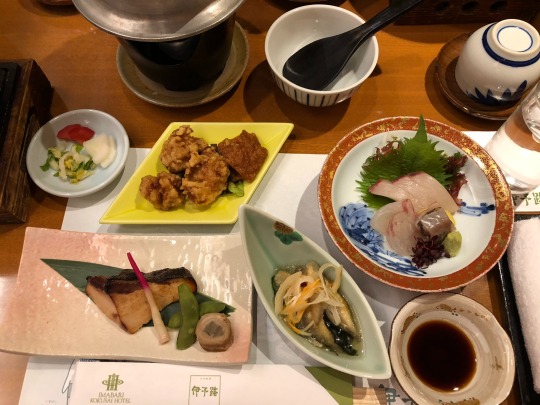
Sukiyaki The meat was cooked at the table. It was very nice.
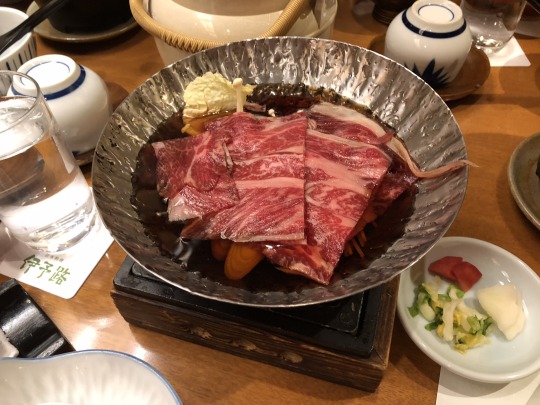
The Hiroshima Peace Memorial Museum made me slightly angry. You can’t get away from the horrific destruction and huge loss of life and the continuing after affects but you look at the mostly Japanese people in the museum and wonder what they think. There was about six lines describing the start of the war and then the rest basically made no mention of Japan’s part In the war.
We have asked Kymie about what is taught in the school and the whole period of World War Two is not taught at all so people really don’t understand why the bombs were dropped. Children wonder why American would do this to them. Apparently, even today, the Japanese government doesn’t want to take any responsibility for what happened. Kymie has said on a number of occasions Japan got into the war because of one bad general and that’s the full story. Access to the internet has allowed the Japanese to know more.
0 notes
Text
Hiroshima Peace Memorial Park also known as the Atomic Bomb Dome, it is located in Hiroshima. Japan Hiroshima Peace Memorial Park was established in 1996 (1996) and was registered as a World Heritage Site in the same year. The original building was designed by the Czech architect Jan Letzel. Completed in April 1915 (1915) was named. Hiroshima Prefectural Commercial Exhibition (HMI) was launched in August of the same year. In 1921, it was renamed the Hiroshima Prefectural Commercial Exhibition.
Hiroshima Prefectural Products Exhibition Hall and in 1933 changed its name again. Hiroshima Prefectural Industrial Promotion Hall On 6 August 1945, an atomic bomb was dropped near the building. The building is located near the center of most explosions. The building was preserved after being bombed. It has now become a reminder of the destructive power of the atomic bomb. It is a symbol of hope in peace and against the use of atomic weapons.
Hiroshima Peace Memorial Park in Hiroshima, Japan Hiroshima Peace Memorial Park also known as the Atomic Bomb Dome, it is located in Hiroshima. Japan Hiroshima Peace Memorial Park was established in 1996 (1996) and was registered as a World Heritage Site in the same year.
0 notes
Photo

The Hiroshima Prefectural Commercial Exhibition Hall .. [Before]
A model of the A-bomb dome as it was before Aug 6, 1945. At the Hiroshima Peace Memorial Museum, Hiroshima, Chugoku.
Originally designed by Czech architect Jan Letzel, and completed in Apr 1915, the Hiroshima Prefectural Commercial Exhibition Hall's business functions included commercial research and consulting services and the display and sale of prefectural products, and the hall was also used for art exhibitions, fairs, and cultural events. It was also known aslater as the Prefectural Industrial Promotion Hall. During WW2, it was taken over by the Chugoku-Shikoku Public Works Office of the Interior Ministry, the Hiroshima Lumber Control Corporation, and other government agencies.
1 note
·
View note